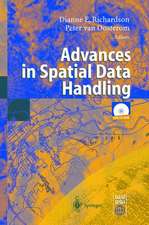Fair Scheduling in High Performance Computing Environments
Autor Art Sedighi, Milton Smithen Limba Engleză Hardback – 3 mai 2019
i. Class A – similar but complementary workloads
ii. Class B – similar but steady vs intermittent workloads
iii. Class C – Large vs small workloads
iv. Class D – Large vs noise-like workloads
This new scheduler achieves short-term fairness for small timescale demanding rapid response to varying workloads and usage profiles. Rawlsian Fair scheduler is shown to consistently benefit workload Classes C and D while it only benefits Classes A and B workloads where they become disproportionate as the number of users increases.
A simulation framework, dSim, simulates the new Rawlsian Fair scheduling mechanism. The dSim helps achieve instantaneous fairness in High Performance Computing environments, effective utilization of computing resources, and user satisfaction through the Rawlsian Fair scheduler.
Preț: 644.15 lei
Preț vechi: 805.19 lei
-20% Nou
Puncte Express: 966
Preț estimativ în valută:
123.27€ • 127.92$ • 103.03£
123.27€ • 127.92$ • 103.03£
Carte tipărită la comandă
Livrare economică 15-29 martie
Preluare comenzi: 021 569.72.76
Specificații
ISBN-13: 9783030145675
ISBN-10: 3030145670
Pagini: 144
Ilustrații: XI, 132 p. 77 illus., 74 illus. in color.
Dimensiuni: 155 x 235 mm
Greutate: 0.38 kg
Ediția:1st ed. 2019
Editura: Springer International Publishing
Colecția Springer
Locul publicării:Cham, Switzerland
ISBN-10: 3030145670
Pagini: 144
Ilustrații: XI, 132 p. 77 illus., 74 illus. in color.
Dimensiuni: 155 x 235 mm
Greutate: 0.38 kg
Ediția:1st ed. 2019
Editura: Springer International Publishing
Colecția Springer
Locul publicării:Cham, Switzerland
Cuprins
Chapter 1 Introduction 1.- Chapter 2 Financial Market Risk 9.- Chapter 3 Scheduling in High Performance Computing 24.- Chapter 4 Fairshare Scheduling 33.- Chapter 5 Multi-Criteria Scheduling: A Mathematical Model 43.- Chapter 6 Simulation & Methodology 56.- Chapter 7 DSIM 67.- Chapter 8 Simulation Scenarios 73.- Chapter 9 Overview of Results 90.- Chapter 10 Class A Results and Analysis 101.- Chapter 11 Class B Results and Analysis 118.- Chapter 12 Class C Results and Analysis 139.- Chapter 13 Class D Results and Simulations 153.- Chapter 14 Conclusion 173.
Recenzii
Notă biografică
Caracteristici
With the prevalence of shared computing environments (cloud for example), how a shared resource (such as a computer/CPU/Core) is distributed and time-shared across many users will be critically important. Current methods and algorithms used to divide resources will simply not work in large shared computing environments. For a large organization such as a bank, or pharma, the method introduced in this book will allow them to create internal shared services hat will scale to the enterprise. This book applies behavioral economics to computing – which opens the door for many applications across the technology sector to do the same.























